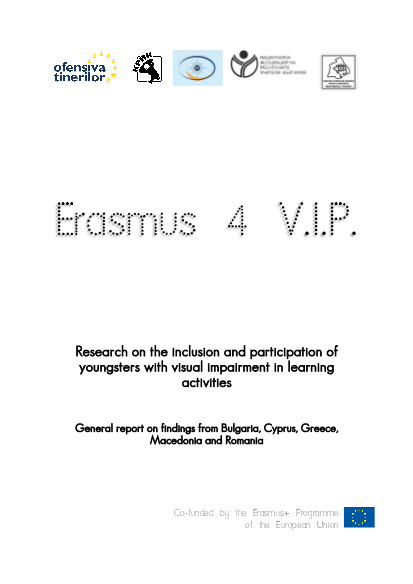Research on the inclusion and participation of youngsters with visual impairment in learning activities
The “Erasmus 4 VIPs” project aimed to identify new ways in which youngsters with disabilities, especially with visual impairments, can get more involved in various social and educational activities. In order to achieve this objective, the project consortium, consisting of five partners from Romania, Greece, Bulgaria, Macedonia and Cyprus considered that first of all it was important to explore the real context of integration of young people with visual impairments. This would become the base on which we could later design powerful resources that youth workers and youth organizations can use to integrate young people with visual impairments in non formal education activities and international mobility.
This activity ran from November 2015 to June 2016, time in which partners carried out a research regarding the participation of young people with visual impairments in their countries, which was compiled in this report.
This research was oriented towards offering:
- Young people with visual impairments the chance to participate in a structured dialogue activity in which they could express their needs, interests and experiences, especially in relation to personal development through various youth activities.
- Different NGOs, public institutions and people with no disability the chance to express their needs, expectations and fears with respect to including people with disabilities in the regular activities, which helped in gaining a wider perspective on the issues discussed.
While the limited resources meant that total number of participating people and bodies could not be enough to consider this research a survey, it did provide partners with relevant input on the realities that surround young people with visual impairments, offering important results in terms of identifying the needs of people with visual impairments and the challenges they are facing. Moreover, even with low number of respondents, the data from the 4 forms did present consistency and we were in most cases able to connect the identified needs and difficulties VIPs are facing to their causes. For example, poor opinions regarding the interaction with public services was correlated with findings about their low accessibility and their lack of policies for supporting the young people with visual impairments addressing them. Also, low number of VIPs being involved in activities of NGOs was correlated with the low accessibility of NGOs, their lack of skills for adapting their activities to the specifics of working with people with visual impairments and to the fact that most NGOs do not consider the need for adapting their work to be more inclusive for vulnerable groups. Furthermore, the recommendations that the working group has made, which can be found in the next sections of this report, take into account just the data that is consistent, so they can be safely used as starting points for future work aimed at creating a more accessible learning and working environment for the young people with visual impairments.
About the research
The research focused mainly on the following topics of interest:
- The actual level of inclusion and participation of young people with visual impairments in learning mobilities;
- The participation of young people with visual impairments in the community;
- The participation of young people with visual impairments in the NGO environment;
- The available support offered for integrating for young people with visual impairments;
- The level of sharing information about European learning opportunities through NGOs, schools, info points to young people with visual impairments;
- Qualitative and quantitative information was collected by using a tool consisting of four different Questionnaires and two Focus Group discussions.;
Data was collected from:
- Institutions and NGOs responsible for education;
- Youth NGOs;
- Schools and NGOs that are working for and with the young people with visual impairments;
- Local institutions;
- Young people with visual impairments;
- Young people without any disabilities;
Partners implementing the activity in the five partner countries were:
- Ofensiva Tinerilor, Romania;
- Magnites Tyfli, Greece;
- Center for Youth Activism CYA KRIK, Macedonia;
- National Association of Resource Teachers - NART, Bulgaria;
- Pancyprian Organization of the Blind, Cyprus;
You can download the consolidated general report, with findings and recommendations from each of the 5 participating countries from here:
Also, you can download the national reports from here:

 English
English  Greek
Greek  Bulgarian
Bulgarian 
